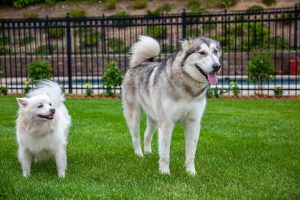Pears are nutrient-rich fruits composed of water, fiber, and natural sugars. They offer vitamins such as C and K, along with antioxidants. When considering feeding dogs, pears can be suitable in moderation, with seeds and core removed to prevent harm. Always introduce new foods cautiously and consult your vet for guidance.
In this post, we’ll see whether you can feed your dog pears, what are their benefits, harmful effects and most importantly, things to know (facts) about pears. Additionally, we would also take a look at the nutritional value and the proper way to feed dogs pears. Finally, we will answer the most important questions about this topic and share the final verdict.
But, firstly – let’s see, can dogs eat pears?

Table of Contents
ToggleCan Dogs Eat Pears Safely?
Yes, dogs can eat pears in moderation. Offer bite-sized, seedless slices. Remove seeds and the core to avoid choking hazards. Pears provide hydration, fiber, and essential vitamins like C and K. However, excess consumption may lead to digestive issues, so feed them sparingly as a tasty, nutritious treat for your furry friend.
Benefits of Feeding Your Dog Pears (5 Benefits)
Pears are beneficial to dogs. Here is a list of 5 benefits of pears for dogs:
- Rich in Vitamins and Minerals: Pears provide essential vitamins and minerals, including vitamin C and potassium, contributing to overall canine health.
- High Water Content for Hydration: With a high water content, pears can contribute to your dog’s hydration, supporting their overall well-being.
- Dietary Fiber for Digestive Health: The dietary fiber in pears aids in digestion, promoting a healthy digestive system in dogs.
- Supports Immune System with Antioxidants: Pears contain antioxidants that help support your dog’s immune system, protecting against oxidative stress.
- Low in Calories, Suitable for Weight Management: Being low in calories, pears can be a healthy snack option for dogs, especially those on weight management plans.
Harmful Effects of Feeding Your Dog Pears (4 Harms)
Pears can be harmful to dogs. Here is a list of 4 potential harmful effects of feeding dogs pears:
- Upset Stomach: Feeding too many pears may lead to stomach upset or gastrointestinal discomfort in dogs.
- Diarrhea: Excessive pear consumption can result in diarrhea, disrupting your dog’s digestive balance.
- High Sugar Content: Pears contain natural sugars, and overconsumption may contribute to weight gain and issues related to high sugar intake.
- Choking Hazard: The seeds and core of pears pose a choking hazard, and dogs should not be allowed to consume them.
Things to Know About (Facts) about Pears
In this section, we will discuss some facts and things to know about pears.
| Attribute | Description |
| Type | Pears belong to the Rosaceae family and come in various types, such as Anjou, Bosc, and Bartlett. |
| Color | Pears exhibit different colors when ripe, including green, yellow, and red. |
| Texture | The texture of pears can range from crisp to buttery, depending on the variety and ripeness. |
| Flavor | Pears offer a sweet and juicy flavor with subtle variations among different types. |
| Nutrients | Pears are rich in dietary fiber, vitamins (C and K), and minerals (potassium). |
| Sugar Content | Pears contain natural sugars, contributing to their sweet taste. |
| Ripeness | Pears should be consumed when ripe for optimal taste and texture. |
| Core and Seeds | The core and seeds of pears contain trace amounts of cyanide and should be removed before feeding dogs. |
Nutritional Value of Pears
In this section, we will discuss the nutritional value of pears.
| Nutrient | Value per 100 g | Unit |
| Calories | 57 | Kcal |
| Water | 83.96 | g |
| Protein | 0.36 | g |
| Carbohydrates | 15.23 | g |
| Sugars | 9.75 | g |
| Fiber | 3.1 | g |
| Fat | 0.14 | g |
| Vitamin C | 3.1 | mg |
| Vitamin K | 4.4 | µg |
| Potassium | 119 | mg |
| Phosphorus | 11 | mg |
| Magnesium | 9 | mg |
How to Feed Dogs Pears?
Here is a 5-step guide on how to feed dogs pears:
- Wash the Pear: Ensure to wash the pear thoroughly to remove any pesticides or dirt.
- Peel and Remove Seeds: Peel the skin and remove seeds and core before feeding.
- Cut into Bite-sized Pieces: Slice the pear into bite-sized, manageable pieces for your dog.
- Introduce Small Portions: Start with small portions to monitor for any adverse reactions.
- Monitor While Eating: Supervise your dog while eating to prevent choking hazards.
Things to Take Care of (Precautions) When Feeding Your Dog Pears:
Here are some precautions you must take before you feed your dog pears:
- Moderation is Key: Feed pears in moderation to avoid digestive issues.
- Remove Choking Hazards: Remove seeds and core to prevent choking hazards.
- Check for Allergies: Ensure your dog doesn’t have allergies to pears.
- Consult Your Vet: If introducing pears for the first time, consult your vet for guidance.

Can Dogs Eat Alternative Forms of Pears?
In this section, we will discuss if dogs can eat alternative forms of pears such as cooked pears, canned pears, and more.
Can Dogs Eat Whole Pears?
Yes, dogs can eat whole pears in moderation. Dogs can eat fresh, ripe pears. Remove seeds and core, and cut them into bite-sized pieces. Feed in moderation to avoid digestive issues. Pears contain fiber, vitamins, and antioxidants beneficial for dogs in small quantities.
Can Dogs Eat Pear Slices?
Yes, dogs can eat pear slices. Provide thin, bite-sized slices to prevent choking hazards. Remove seeds and core, and feed in moderation. Pear slices offer a hydrating and nutritious snack for dogs.
Can Dogs Eat Cooked Pears?
It depends. While cooked pears are not toxic, they may lose some nutrients. Ensure no added sugars or spices in cooked pears. Feed in moderation, and monitor for any adverse reactions. Fresh, raw pears are a preferable option for dogs.
Can Dogs Eat Canned Pears?
It depends. Canned pears may contain added sugars or syrup. Choose canned pears in water or natural juice, without added sugars. Feed in moderation, as excessive consumption may lead to digestive issues. Fresh, raw pears are a healthier choice for dogs.
What Other Fruits can a Dog Eat?
Here is a list of 10 other fruits that your dog can eat:
- Apples
- Blueberries
- Strawberries
- Watermelon
- Pineapple
- Mango
- Cranberries
- Cantaloupe
- Raspberries
- Blackberries
Frequently Asked Questions (FAQs)
In this section, we will discuss some frequently asked questions regarding pears and feeding them to dogs.
What is the nutritional profile of pears?
Pears are defined by their nutritional richness. They contain fiber, vitamins C and K, and copper, contributing to a healthy diet for dogs.
Is it safe for dogs to eat pear seeds?
No, dogs should not consume pear seeds. The seeds contain cyanide, which can be harmful. Always remove seeds before offering pears to your dog.
How do pears compare to apples for dogs?
Both pears and apples are safe for dogs. Pears have a slightly higher fiber content, while apples offer a crunchier texture. Moderation is key for either fruit.
What fruits should be avoided for dogs?
While pears are safe, avoid feeding dogs:
- Grapes
- Raisins
- Citrus fruits
- Pits from fruits like peaches and plums
These can be toxic or pose choking hazards.
Conclusion
In conclusion, pears can be a healthy addition to a dog’s diet. With their crisp texture and nutrient-rich profile, pears offer a tasty and safe treat when served in moderation. Remember to remove seeds and provide slices to ensure a delightful and nutritious experience for your canine companion.



